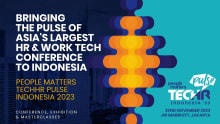The evolutionary role of technology in Human Resources

Flashback Circa. The 1990s when we first started our professional lives, the very thought of Human Resources (HR) brings back memories that evoke feelings of ‘the final frontier’. We were expected to clear the ‘final interview from HR’ to get the offer letter! Once we cleared this ‘stage’ and joined the organization, HR for us was mainly those who addressed induction, payroll concerns and managerial issues. The HR folks would be revered once a year as they would be the ones who stamp the authority on our annual performance reviews and increments. When it came to the question of usage of technology by the HR, well, sure we had a few printers to print confidential information and ‘limited’ computers for HR. Back then, IT expenses for the HR team was considered a huge investment, and the general notion was that HR needed so many systems after all.
Since then, HR has made rapid progress in using technology to add value to the business. Across organization HR today is seen as a crucial business partner and commands a larger say in technology decisions, including how to bring technology closer to employees in the workplace. Today, technology is a crucial enabler for HR, be it in workforce planning, for assessing and accessing the employees across the globe to Employee communications, performance management and their Learning and development.
There has been a shift in HR function today, from being just transactional earlier to more transformational, technology being the prime enabler to the shift. Activities such as payroll management, time management and other administrative functions are technology-driven allowing HR professionals to focus more on employees’ engagement, productivity and talent development. With the diverse workforce organizations today, it is crucial not only having the workplace security and privacy guidelines but also their implementation and monitoring which is aided and possible only by technology, making the workplace safe and secure.
HR solutions that integrate into the whole system have evolved significantly providing HR more insights to use data analytics not just on its employees, but a far wider network of individuals that can help attract the right talent pool. Technology frameworks for hiring, providing workforce analytics such as where to hire from, planning for certain roles, and even aiding in decisions regarding where should expansion take place keeping the right talent mix in mind – all these activities require the efficient use of technology by HR. Tools such as SAP, Oracle, Workday have also helped in the management and retention of talent in a whole new dimension, thereby reducing the total cost of hiring and retaining an employee.
As the workplace becomes dynamic and inclusive, the future of work demands for a constant cycle of upskilling and behavioral skill training for all generations of employees. Today, HR is designing learning programs that help enhance the performance and productivity of individuals as well as engage them to learn. They are identifying ways to utilize advanced technologies to develop new methods of learning, from experiential training to gamification, while having the access to information and best practices from across the globe.
Workplace solutions have started to play a key role, especially with the business defining moments such as the “pandemic” that we are going through currently. HR has a key role in visualizing how we can use technology now when employees continue to work from home, and how we can leverage them as we move forward. The pandemic has resulted in HR being able to act swiftly in defining newer ways of evaluating employees, managing them, monitoring the effectiveness of the remote workplace, and finally report it back with deeper insights. The unprecedented circumstances have made the HR identify new ways to use technology for remote hiring ensuring that the right talent is identified and evaluating the resources in terms of competency. Here, at Collabera, HR played a crucial role in defining the frameworks to ensure that employees at all levels and in varied roles can work effectively from home. The HR, IT and Business teams worked collaboratively on type of tools that can be used and identifying different employee needs to make the transition smooth and successful and monitoring the work, without impacting the privacy of employees at home.
HR used to be late adopters of technology, but that has changed in the last decade or so. Today, any discussion of technology investments is incomplete without HR inputs. Organizations are recognizing the significant business benefits of combining the HR with technology which results in a separate allocation of technology budgets to the HR function. Today, HR holds a commanding seat on the table where decisions about technology investments are made. As we move forward, HR should play a more proactive role especially with the advent of Data Analytics, AI/NLP. With abundant information about every employee available, HR today is well-poised to stand at the forefront of utilizing new-age technologies and making a larger impact on organizational success while ensuring employees’ satisfaction, safety and privacy.
















